ReadWriteWeb Turns 20: Writing to the Web Then and Now
I look back on two decades of my former tech blog, ReadWriteWeb ☯️, including the more than 10 years since I left. It can be frustrating to see something I built up turn into...something else.

Twenty years ago, on 20 April 2003, I published the first post on a blog I had just started. Entitled The Read/Write Web, it was a manifesto of sorts. The post was filled with optimism for the web and made the case that a new era was just beginning. A “Web 2.0,” if you will (although that term had yet to be invented). Reading the following introductory paragraph now, as a grizzled and grey-bearded web veteran, I rather like the passion and wide-eyed idealism of this young, nascent blogger:
The World Wide Web in 2003 is beginning to fulfil the hopes that Tim Berners-Lee had for it over 10 years ago when he created it. The web was never just supposed to be a one-way publishing system, but the first decade of the web has been dominated by a tool which has been read-only - the web browser. The goal now is to convert the web into a two-way system. Ordinary people should be able to write to the web, just as easily as they can browse and read it.
From that single, rose-tinted paragraph, one of the defining tech blogs of the Web 2.0 era was born.
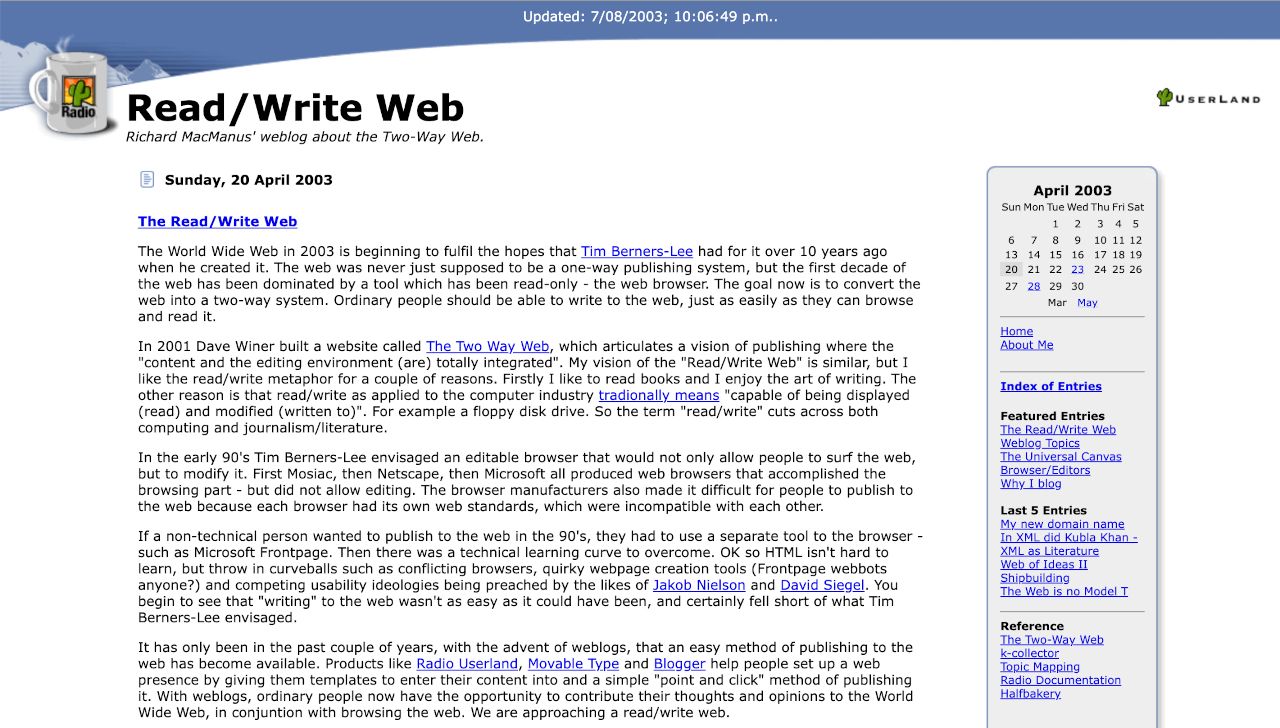
But…twenty years is a long time ago. And I need to fess up: I’ve now spent more than half of the past two decades not working for RWW. I sold the business at the end of 2011 and continued working for the site until October 2012, at which point I left. So it’s been over a decade now since I had anything to do with RWW.
The Fate of RWW
Normally in a nostalgic post about my ol’ tech blog, I’d start by recounting the glory days. But in this case, let me first tell you how it ended.
You might be surprised to learn that RWW still exists. But sadly, it’s the kind of existence you’d normally associate with the walking dead. The current version of “ReadWrite” (the name was changed as soon as I walked out the door) is a plain, insipid website devoted to a wide variety of trendy tech buzzwords: AI, Blockchain, Connected Devices, Fintech, Smart Cities, etc. As for the recent content, it reads like it was written by a generative AI program — but not ChatGPT, more like Google Bard.

It depresses me what RWW has turned into. It was such a colourful, vibrant blog in its heyday, when it was written by a group of talented, passionate bloggers (I wrote about all those amazing people who worked for RWW in my 10th anniversary post).
But I’m not the only tech blog founder this has happened to. summed it up well in his post about the demise of Recode:
“The tech blog era didn’t pan out for most, from GigaOm to Mashable to Pando Daily. You could argue that the lure of scale (and dominance of ad models) are to blame. TechCrunch ended up the most enduring brand, improbably surviving and even growing after an acquisition by AOL, executing a fairly standard industry publication model. Business Insider, of course, takes the crown, particularly in regards to lucrative exits to Germans.”
TechCrunch is still a good site today, although it’s missing the edge and outsized personality that Mike Arrington gave it back in the day. But the reality is, most other tech blogs of that TC and RWW vintage either failed or lost their way. RWW didn’t fail — I managed to sell it, after all. But it certainly lost its way after I left.
The Glory Years: 2003-2011

I’m currently writing a book about my experiences building RWW — I’m calling it my “Web 2.0 memoir.” Roughly speaking, 2003-04 were the amateur years, 2005-06 was the start of RWW turning into a proper media business, 2007 is when I began hiring people (including Marshall Kirkpatrick, who became the blogging yang to my yin), 2008 was an eventful year in which I nearly sold the business (that’s a doozy of a story, which I haven’t yet told the world), 2009 was our first event, 2010 was a crazy-hectic year of travel, more events and more growth, and 2011 was the final hurrah before I sold the company in December.
Recalling those times first thing every weekday morning, as I open up Scrivener and spend a couple of hours writing my book, has been a real pleasure. It’s also been a constant reminder of how much the internet has changed over the past two decades.
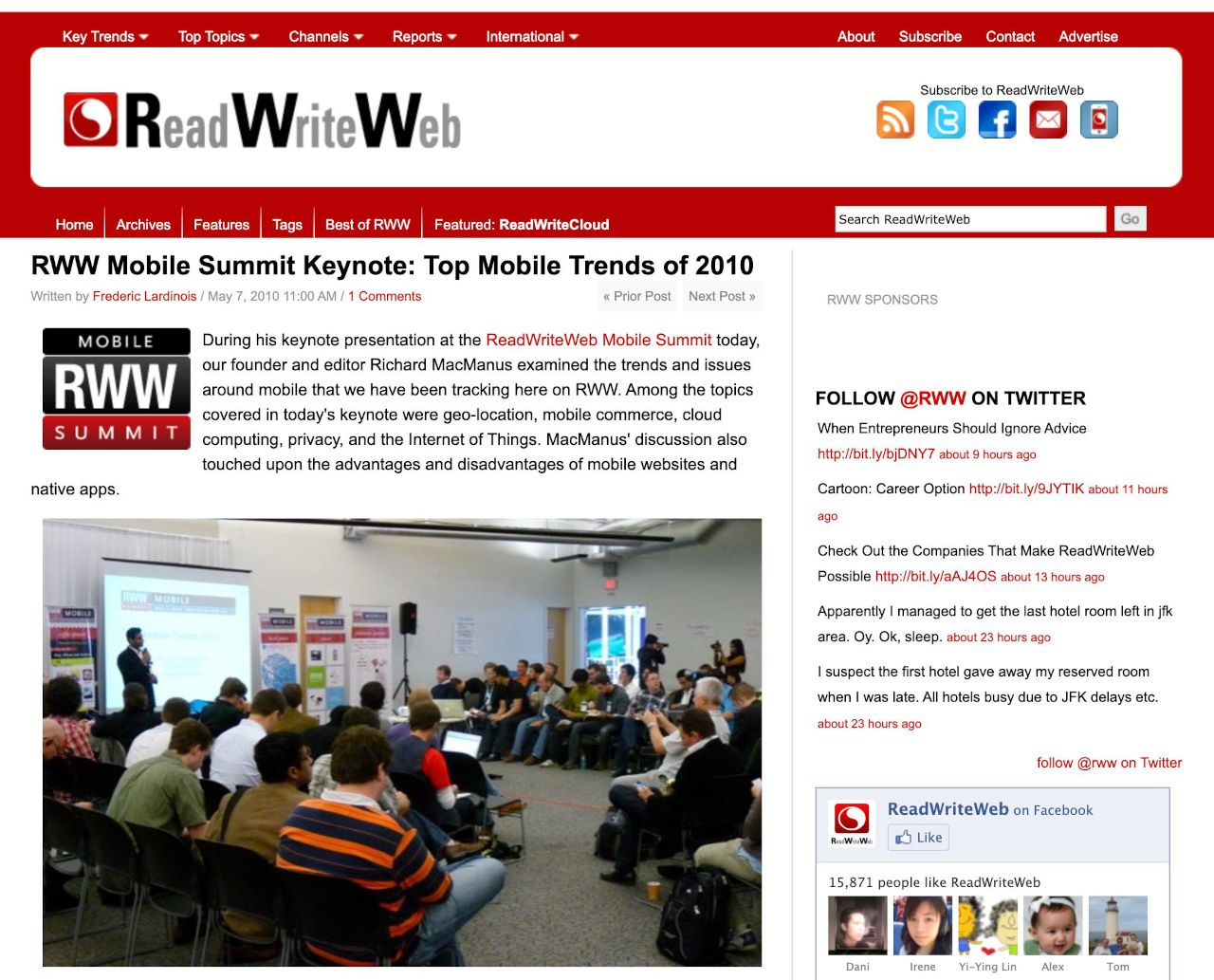
Take blogging itself. People don’t have blogs anymore, now they have email newsletters. People used to read blogs in their RSS Readers, and you would visit the website to leave a comment — or write your own blog post in reply, which would show up as a trackback link on the original. The “blogosphere” was truly a marvel of the distributed web; and, not coincidentally, it was run mostly on open source software.
I had actually started out blogging on Radio Userland, desktop software that I’d paid for. But in 2004, I switched to Movable Type, which was open source and browser-based. When RWW turned into a group blog, we flirted with moving to WordPress — which became the blogging software of choice for most people during the Web 2.0 era. We ended up sticking with MT; but either way, the blogosphere was almost entirely run on open source software during its prime.
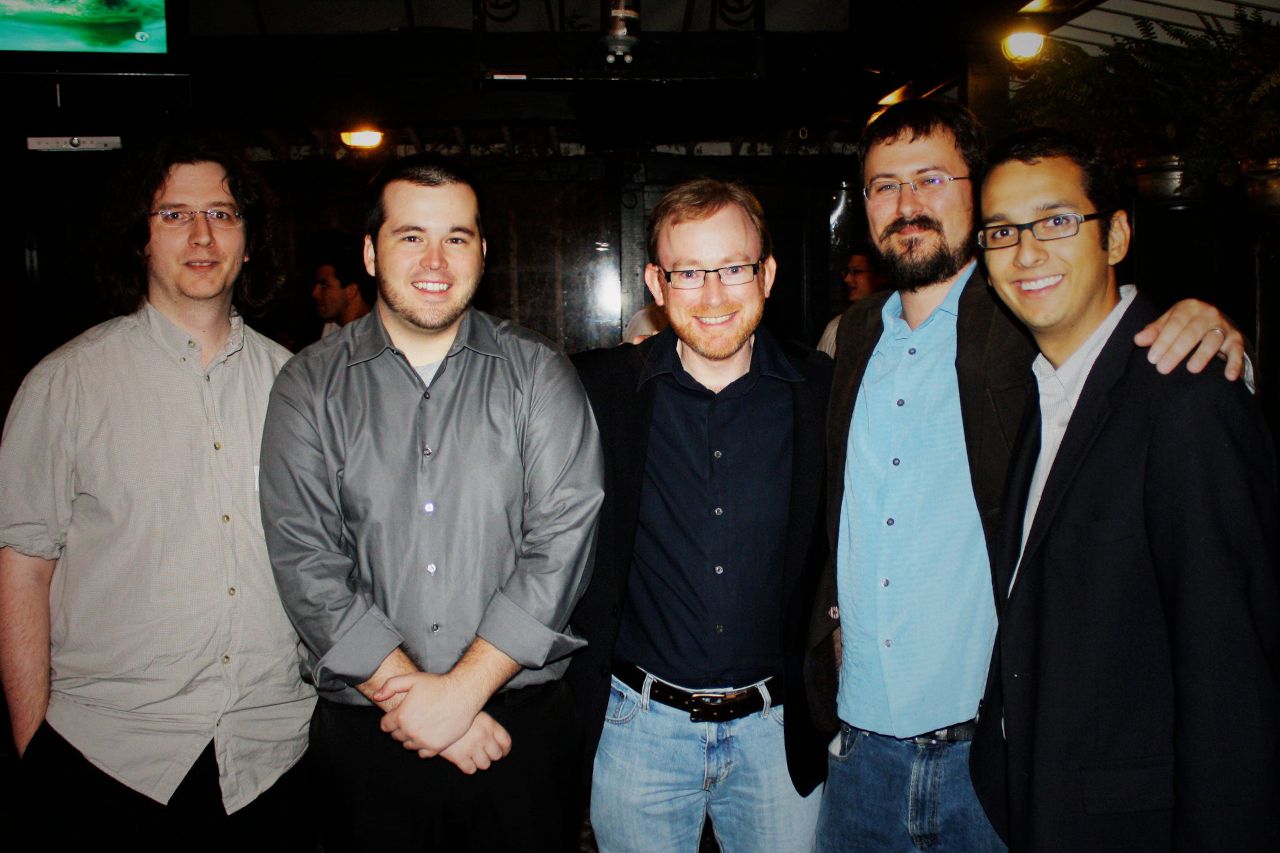
Writing to the Web
I’m well aware of the irony of writing this email newsletter in a proprietary, closed software platform: Substack. Haven’t I learned anything in 20 years? I saw firsthand how centralized social media platforms, like Facebook and Twitter, emerged during the 2000s and then ultimately usurped blogging in the 2010s.
What can I say, except that I like Substack’s publishing tools, I like its focus on helping writers monetize their work, and I want to reach the large network of readers that Substack has. (However, I am backing up each of my posts to a private WordPress blog, just in case.)
There are open source alternatives to Substack — Ghost gets mentioned a bit — but 90% of the battle with email newsletters is getting readers. Large networks matter in newsletters; moreso than in blogging. When I was a young blogger, I made a name for myself by catching the attention of more experienced bloggers — either by linking to them (which they would see via the trackback system) or by commenting on their blogs. By comparison, it’s difficult to gain the attention of other newsletter writers; not least because linking has gone out of fashion. So joining an established network like Substack is a way to ‘stay in the game.’
The upshot is that, unfortunately, the “write” part of the read/write web is now dominated by centralized platforms, like Substack — but even more egregiously, like Elon Musk’s Twitter, Mark Zuckerberg’s Facebook and Instagram, and the Chinese government’s TikTok. It’s grim, and we really only have the still tiny fediverse (Mastodon and similar decentralized apps) to grasp onto, as a small hope for an open web future.
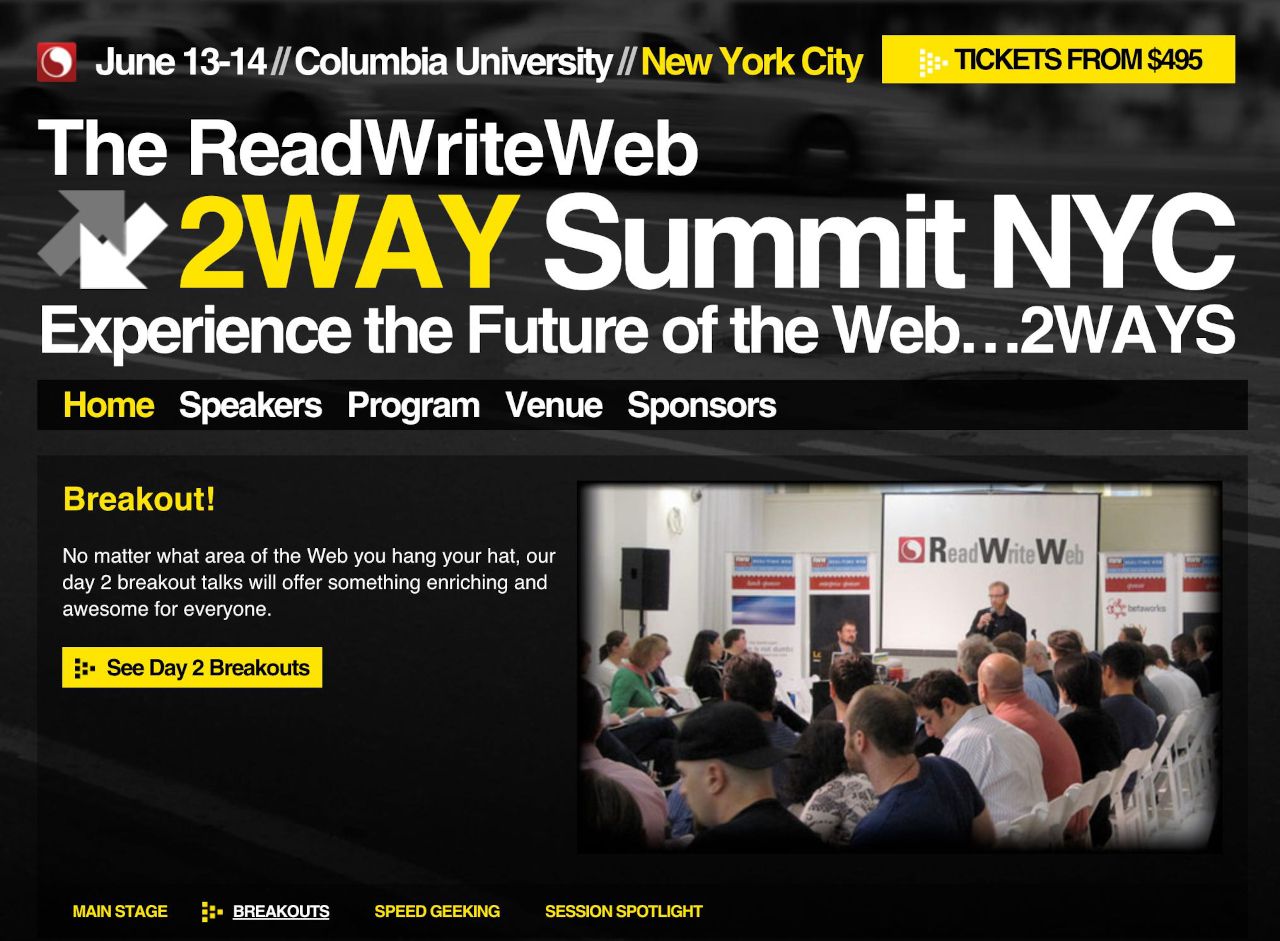
The other signficant difference between 2003 and 2023 is the recent emergence of powerful AI software, like ChatGPT, which looks set to re-write the way the internet works over the rest of the 2020s. That’s a story yet to be written, but put it this way…if I was starting ReadWriteWeb all over again in 2023, I’d be creating it as a conversational chat app. I like to think RWW would reach the same type of audience — thoughtful, analytical, early adopter tendancies, not at all shallow — but it would serve the needs of that audience using a different interface.
I’d also try to find a way to merge Large Language Models with RWW’s unique data set (a.k.a. blog posts), so that readers get something of value beyond whatever bland thing ChatGPT outputs.
Software Ate the World
Many internet trends have come and gone over the past twenty years. It used to be ReadWriteWeb’s calling card: identifying trends early, investigating them, and writing them up. In the early days, it was also about “eating your own dog food” — a favourite saying of a CIO I used to work for before I started RWW. In other words, I regularly used and experimented with the very web technologies I wrote about: blogging, RSS, wikis, PHP, JavaScript, CSS, “social software” (the term du jour before “social media” got coined). RWW was also early to jump on cloud computing and smartphone apps, as those trends emerged over 2007-08.
I often wonder if I sold too early. A San Francisco company called SAY Media acquired RWW at the end of 2011, when it was still relatively early in the “software is eating the world” phenomenon. Indeed, Marc Andreessen only coined that expression in August 2011, when he published his famous essay. He got it right, too. The 2010s turned into an extended bull market, bizarrely even through the Covid-19 pandemic.
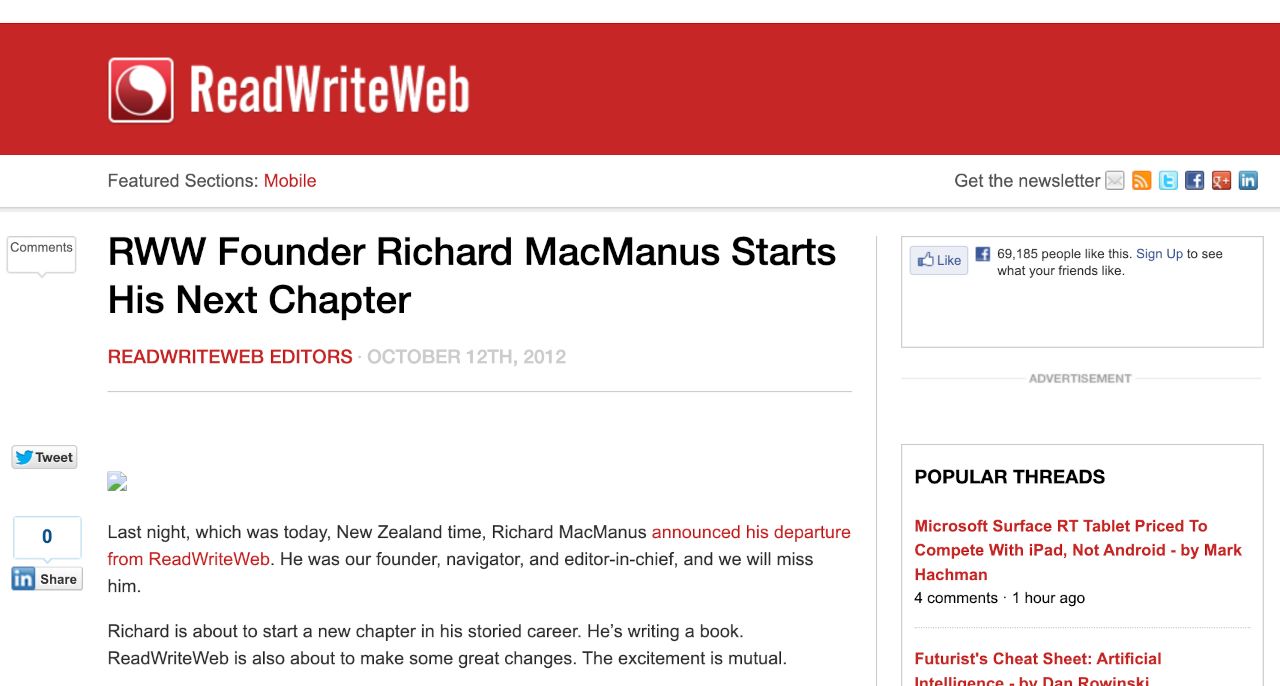
In hindsight, I don’t regret selling, as there were valid reasons to sell at that time. Some were personal, but also there were many complications to running an international business from New Zealand. I wanted RWW to scale, in order to continue competing with the likes of TechCrunch and Mashable, and I thought selling to a bigger, better funded US media company would enable RWW to do that.
Of course, the problem with selling your company is that you lose control. SAY Media replaced me in October 2012 with the guy who wrote the “Fake Steve Jobs” blog. I thought it was an odd choice, but hey, they paid me to go away and also it wasn’t my decision anymore. (Fake Steve Jobs lasted less than five months and later wrote a satirical book about his next victim employer.)
The next editor was Owen Thomas, who I liked and thought did a good job of trying to bring RWW back to its true values. He kept in touch with me and sought my feedback about the direction of the site, which I appreciated. But despite Owen’s hard work, SAY Media couldn’t re-gain RWW’s glory years (this effort wasn’t helped by the switch in domain name, which apparently caused crucial problems with SEO ranking).
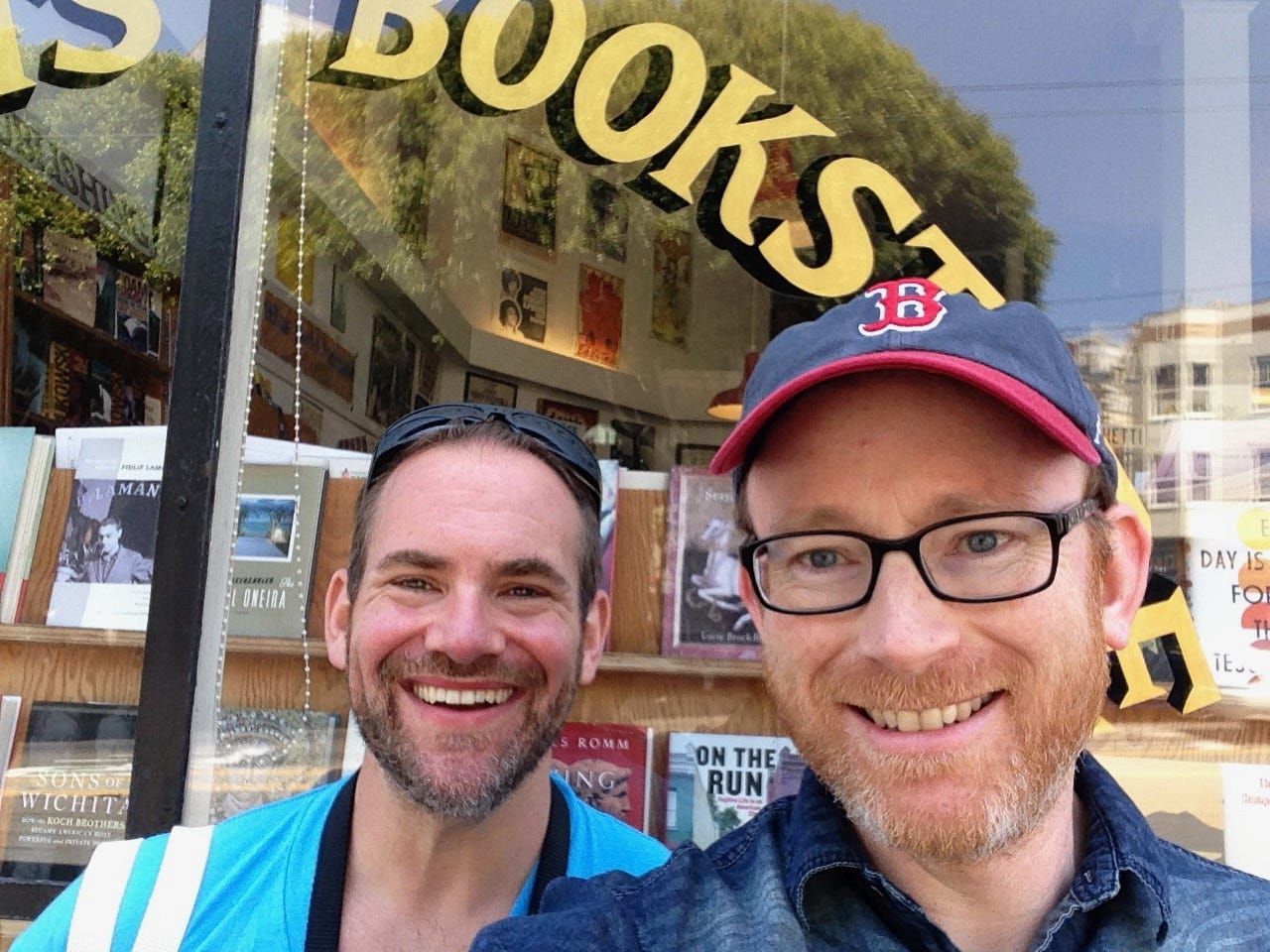
At the start of 2015, SAY Media on-sold RWW to another company, called Wearable World. Owen stayed on and kept me in the loop with the goings-on, but eventually he departed in early 2016.
By the time Owen left, the company that owned RWW was now called Wearable IoT World. But in late 2016, it annoyingly re-named itself once again, this time to “ReadWrite Labs.” This had the unfortunate side effect of several people now claiming to be co-founders of RWW!
The number of RWW co-founders exponentially increased as the years passed. The current editor, as of 2023, is a guy I’ve never heard of who used to work for Crunchbase. In his LinkedIn profile, he lists himself as “Co-founder & Editor In Chief” of ReadWrite.
Anyway…
Since I left RWW back in October 2012, there have been various internet trends that have caused a buzz in the industry — crypto/Web3, “cloud native”, the metaverse, to name a few. I got excited about some of these trends and wished I had been able to blog about them on ReadWriteWeb. But other sites arose to cover those trends instead (indeed, I now work for one of them — The New Stack, founded by ex-RWWer Alex Williams in 2014).
In the final analysis, I think RWW was defined by its era — Web 2.0 — and that era ended around the time I left the blog. Indeed, that’s why I’m writing my Web 2.0 memoir — to tell my story…about both ReadWriteWeb and the read/write web.
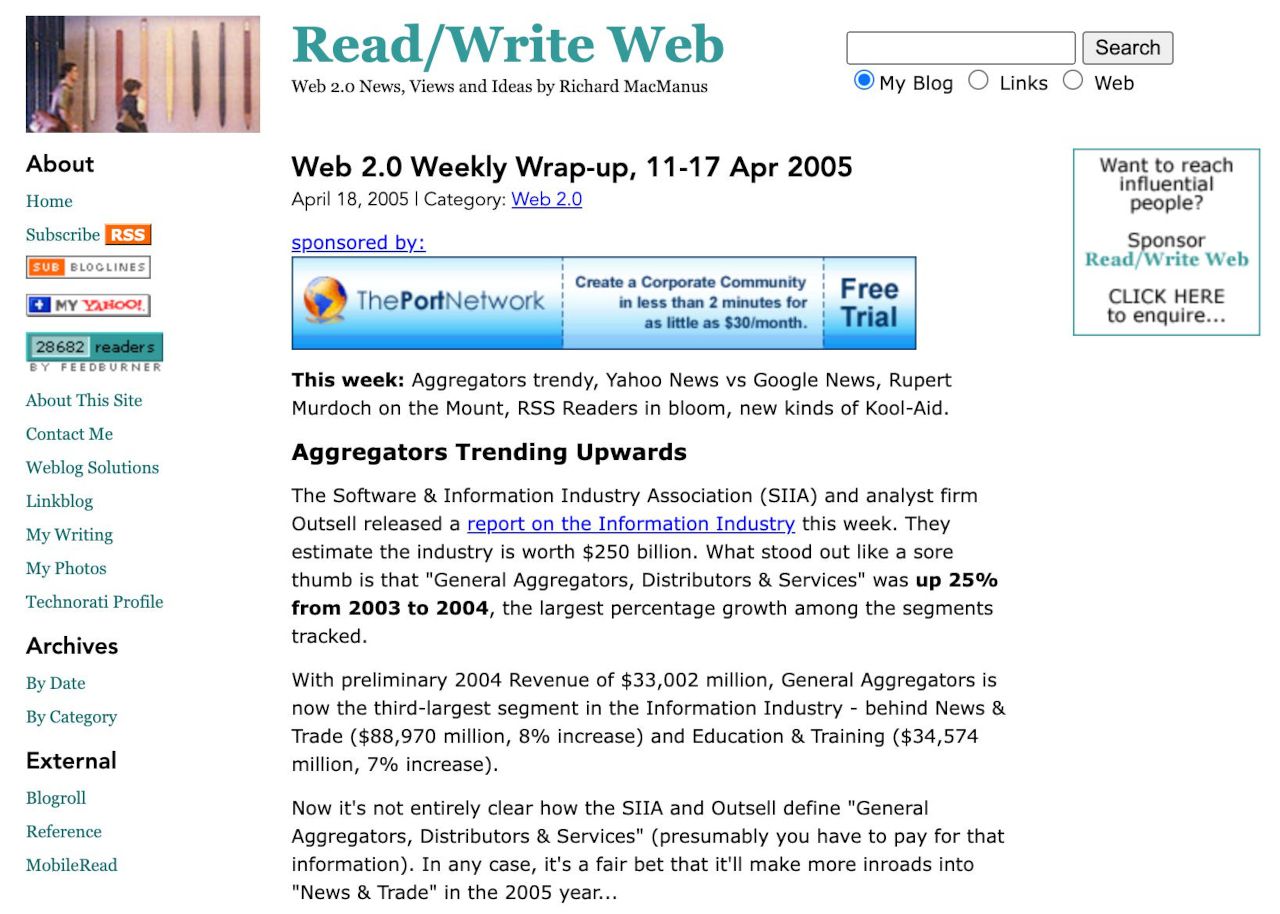
Buy the Book
My Web 2.0 memoir, Bubble Blog: From Outsider to Insider in Silicon Valley's Web 2.0 Revolution, is now available to purchase:
- Paperback, US$19.99: Amazon; Bookshop.org
- eBook, US$9.99: Amazon Kindle Store; Apple Books; Google Play
Or search for "Bubble Blog MacManus" on your local online bookstore.